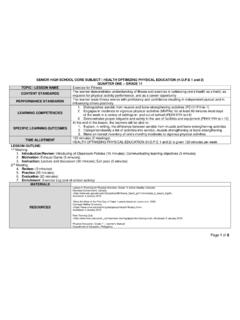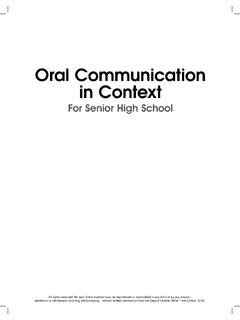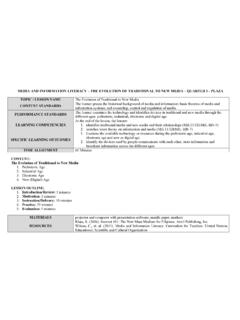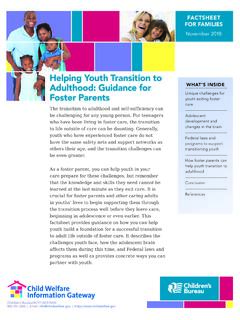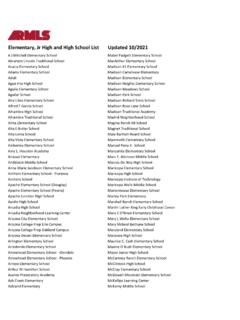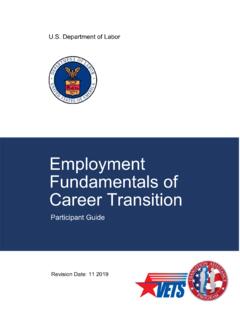Transcription of TEACHING GUIDE FOR SENIOR HIGH SCHOOL Basic Calculus
1 TEACHING GUIDE FOR SENIOR high SCHOOL Basic Calculus CORE SUBJECT This TEACHING GUIDE was collaboratively developed and reviewed by educators from public and private schools, colleges, and universities. We encourage teachers and other education stakeholders to email their feedback, comments, and recommendations to the Commission on Higher Education, K to 12 transition Program Management Unit - SENIOR high SCHOOL Support Team at We value your feedback and on Higher Education in collaboration with the Philippine Normal UniversityThis TEACHING GUIDE by the Commission on Higher Education is licensed under a Creative Commons Attribution-NonCommercial-ShareAlike International License. This means you are free to: Share copy and redistribute the material in any medium or format Adapt remix, transform, and build upon the material. The licensor, CHED, cannot revoke these freedoms as long as you follow the license terms.
2 However, under the following terms: Attribution You must give appropriate credit, provide a link to the license, and indicate if changes were made. You may do so in any reasonable manner, but not in any way that suggests the licensor endorses you or your use. NonCommercial You may not use the material for commercial purposes. ShareAlike If you remix, transform, or build upon the material, you must distribute your contributions under the same license as the original. Printed in the Philippines by EC-TEC Commercial, No. 32 St. Louis Compound 7, Baesa, Quezon City, by the Commission on Higher Education, 2016 Chairperson: Patricia B. Licuanan, Commission on Higher Education K to 12 transition Program Management Unit Office Address: 4th Floor, Commission on Higher Education, Garcia Ave., Diliman, Quezon City Telefax: (02) 441-1143 / E-mail Address: DEVELOPMENT TEAM Team Leader: Jose Maria P.
3 Balmaceda, Writers: Carlene Perpetua P. Arceo, Richard S. Lemence, Oreste M. Ortega, Jr., Louie John D. Vallejo, Technical Editors: Jose Ernie C. Lope, Marian P. Roque, Copy Reader: Roderick B. Lirios Cover Artists: Paolo Kurtis N. Tan, Renan U. Ortiz CONSULTANTS THIS PROJECT WAS DEVELOPED WITH THE PHILIPPINE NORMAL UNIVERSITY. University President: Ester B. Ogena, VP for Academics: Ma. Antoinette C. Montealegre, VP for University Relations & Advancement: Rosemarievic V. Diaz, Ma. Cynthia Rose B. Bautista, , CHED Bienvenido F. Nebres, , , Ateneo de Manila University Carmela C. Oracion, , Ateneo de Manila University Minella C. Alarcon, , CHED Gareth Price, Sheffield Hallam University Stuart Bevins, , Sheffield Hallam University SENIOR high SCHOOL SUPPORT TEAM CHED K TO 12 transition PROGRAM MANAGEMENT UNIT Program Director: Karol Mark R.
4 Yee Lead for SENIOR high SCHOOL Support: Gerson M. Abesamis Lead for Policy Advocacy and Communications: Averill M. Pizarro Course Development Officers: Danie Son D. Gonzalvo, John Carlo P. Fernando Teacher Training Officers: Ma. Theresa C. Carlos, Mylene E. Dones Monitoring and Evaluation Officer: Robert Adrian N. Daulat Administrative Officers: Ma. Leana Paula B. Bato, Kevin Ross D. Nera, Allison A. Danao, Ayhen Loisse B. DalenaiContentsIntroduction .. ivDepEd Basic Calculus Curriculum GUIDE .. vii1 Limits and Continuity .. 1 Lesson 1: The Limit of a Function: Theorems and Examples .. 2 Topic : The Limit of a Function .. 3 Topic : The Limit of a Function at c versus the Value of a Function at c .. 17 Topic : Illustration of Limit Theorems ..22 Topic : Limits of Polynomial, Rational, and Radical Functions .. 28 Lesson 2: Limits of Some Transcendental Functions and Some Indeterminate Forms.
5 38 Topic : Limits of Exponential, Logarithmic, and Trigonometric Functions ..39 Topic : Some Special Limits .. 46 Lesson 3: Continuity of Functions .. 52 Topic : Continuity at a Point .. 53 Topic : Continuity on an Interval .. 58 Lesson 4: More on Continuity .. 64 Topic : Different Types of Discontinuities .. 65 Topic : The Intermediate Value and the Extreme Value Theorems .. 75 Topic : Problems Involving Continuity .. 852 Derivatives .. 89 Lesson 5: The Derivative as the Slope of the Tangent Line .. 90 Topic : The Tangent Line to the Graph of a Function at a Point .. 91 Topic : The Equation of the Tangent Line ..100 Topic : The Definition of the Derivative .. 107 Lesson 6: Rules of Differentiation ..119 Topic : Differentiability Implies Continuity .. 120iiTopic : The Differentiation Rules and Examples Involving Algebraic, Exponential, and Trigonometric Functions.
6 126 Lesson 7: Optimization ..141 Topic : Optimization using Calculus .. 142 Lesson 8: Higher-Order Derivatives and the Chain Rule .. 156 Topic : Higher-Order Derivatives of Functions .. 157 Topic : The Chain Rule .. 162 Lesson 9: Implicit Differentiation .. 168 Topic : What is Implicit Differentiation? ..169 Lesson 10: Related Rates .. 180 Topic : Solutions to Problems Involving Related Rates .. 1813 Integration ..191 Lesson 11: Integration ..192 Topic : Illustration of an Antiderivative of a Function .. 193 Topic : Antiderivatives of Algebraic Functions .. 196 Topic : Antiderivatives of Functions Yielding Exponential Functions and Logarithmic Functions .. 199 Topic : Antiderivatives of Trigonometric Functions ..202 Lesson 12: Techniques of Antidifferentiation .. 204 Topic : Antidifferentiation by Substitution and by Table of Integrals ..205 Lesson 13: Application of Antidifferentiation to Differential Equations.
7 217 Topic : Separable Differential Equations .. 218 Lesson 14: Application of Differential Equations in Life Sciences .. 224 Topic : Situational Problems Involving Growth and Decay Problems ..225 Lesson 15: Riemann Sums and the Definite Integral ..237 Topic : Approximation of Area using Riemann Sums .. 238 Topic : The Formal Definition of the Definite Integral .. 253 Lesson 16: The Fundamental Theorem of Calculus .. 268 Topic : Illustration of the Fundamental Theorem of Calculus ..269 Topic : Computation of Definite Integrals using the Fundamental Theorem of Calculus .. 273iiiLesson 17: Integration Technique: The Substitution Rule for Definite Integrals ..280 Topic : Illustration of the Substitution Rule for Definite Integrals .. 281 Lesson 18: Application of Definite Integrals in the Computation of Plane Areas ..292 Topic : Areas of Plane Regions Using Definite Integrals.
8 293 Topic : Application of Definite Integrals: Word Problems .. 304 Biographical Notes .. 309ivIntroductionAs the Commission supports DepEd s implementation of SENIOR high SCHOOL (SHS), it upholds the vision and mission of the K to 12 program, stated in Section 2 of Republic Act 10533, or the Enhanced Basic Education Act of 2013, that every graduate of Basic education be an empowered individual, through a program rooted competence to engage in work and be productive, the ability to coexist in fruitful harmony with local and global communities, the capability to engage in creative and critical thinking, and the capacity and willingness to transform others and oneself. To accomplish this, the Commission partnered with the Philippine Normal University (PNU), the National Center for Teacher Education, to develop TEACHING Guides for Courses of SHS. Together with PNU, this TEACHING GUIDE was studied and reviewed by education and pedagogy experts, and was enhanced with appropriate methodologies and strategies.
9 Furthermore, the Commission believes that teachers are the most important partners in attaining this goal. Incorporated in this TEACHING GUIDE is a framework that will GUIDE them in creating lessons and assessment tools, support them in facilitating activities and questions, and assist them towards deeper content areas and competencies. Thus, the introduction of the SHS for SHS SHS for SHS Framework The SHS for SHS Framework, which stands for Saysay-Husay-Sarili for SENIOR high SCHOOL , is at the core of this book. The lessons, which combine high -quality content with flexible elements to accommodate diversity of teachers and environments, promote these three fundamental concepts:SAYSAY: MEANING Why is this important? Through this TEACHING GUIDE , teachers will be able to facilitate an understanding of the value of the lessons, for each learner to fully engage in the content on both the cognitive and affective levels.
10 HUSAY: MASTERY How will I deeply understand this? Given that developing mastery goes beyond memorization, teachers should also aim for deep understanding of the subject matter where they lead learners to analyze and synthesize knowledge. SARILI: OWNERSHIP What can I do with this? When teachers empower learners to take ownership of their learning, they develop independence and self-direction, learning about both the subject matter and Parts of the TEACHING GUIDE This TEACHING GUIDE is mapped and aligned to the DepEd SHS Curriculum, designed to be highly usable for teachers. It contains classroom activities and pedagogical notes, and integrated with innovative pedagogies. All of these elements are presented in the following parts: Highlight key concepts and identify the essential questions Show the big picture Connect and/or review prerequisite knowledge Clearly communicate learning competencies and objectives Motivate through applications and connections to real-life Give a demonstration/lecture/simulation/hands-o n activity Show step-by-step solutions to sample problems Use multimedia and other creative tools Give applications of the theory Connect to a real-life problem if applicable Discuss worked-out examples Provide easy-medium-hard questions Give time for hands-on unguided classroom work and discovery Use formative assessment to give feedback Provide additional examples and applications Introduce extensions or generalisations of concepts Engage in reflection questions Encourage analysis through higher order thinking prompts Supply a
